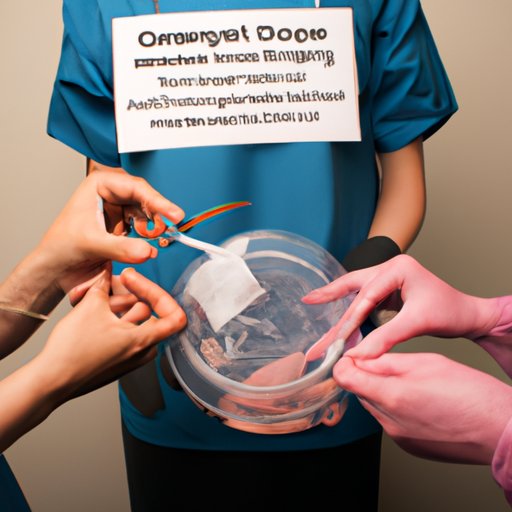Introduction
Male to female gender reassignment surgery is a procedure that involves altering a person’s physical appearance and functioning of their existing sexual characteristics to resemble that of a female. The goal of this surgery is to help individuals who identify as transgender feel more comfortable in their own bodies and enable them to lead lives that are more congruent with their gender identity.
The process of gender reassignment surgery can be both physically and emotionally challenging, so it is important to understand the risks and benefits associated with the procedure before making a decision. This article will provide an overview of the process and explore the various aspects of male to female gender reassignment surgery in depth.

Exploring the Process of Male to Female Gender Reassignment Surgery
Gender reassignment surgery is a complex procedure that involves several different steps. Depending on the individual, some of these steps may include hormone therapy, facial feminization surgery, breast augmentation, and genital reconstruction. In addition, there are a variety of techniques used to create a more feminine appearance, such as electrolysis, laser hair removal, and voice training.
Types of Male to Female Surgery
The most common type of male to female gender reassignment surgery is genital reconstruction, which involves creating a vagina and clitoris out of existing tissue. This is usually done using a technique known as penile inversion, which involves removing the penis and testicles and then inverting the skin to create a functional vagina. Other techniques such as labiaplasty and vaginoplasty can also be used to refine the appearance of the vagina and clitoris.
Facial feminization surgery is another type of male to female gender reassignment surgery. This procedure typically involves reshaping the jaw and forehead, as well as softening the angles of the face. In addition, some patients may opt to have breast augmentation, either through implants or fat grafting.
Benefits and Risks of Surgery
One of the main benefits of male to female gender reassignment surgery is that it can greatly improve self-confidence and quality of life. Many individuals report feeling more comfortable in their own skin after undergoing the procedure, as it enables them to live as their true gender. Additionally, the procedure can reduce or eliminate gender dysphoria, a condition characterized by distress over the mismatch between one’s gender identity and physical sex.
There are also some risks associated with male to female gender reassignment surgery. These can include infection, scarring, and nerve damage. In addition, there is a possibility of complications during the procedure itself, such as bleeding or excessive swelling. It is important to discuss these risks with your doctor before deciding to proceed with the surgery.

How to Prepare for Male to Female Gender Reassignment Surgery
Before undergoing male to female gender reassignment surgery, it is important to ensure that you are physically and mentally prepared for the procedure. The following tips can help you get ready for the process:
Physical Preparation
Prior to the surgery, you should make sure that you are in good physical health. This means eating a healthy diet, exercising regularly, and avoiding drugs and alcohol. Your doctor may also recommend taking certain vitamins and supplements to help support your body during the recovery period.
Mental Preparation
It is also important to prepare yourself mentally for the surgery. This includes talking to a therapist about any concerns or worries you may have, as well as developing a plan to cope with any potential side effects. Additionally, it is important to make sure that you are surrounded by a supportive network of family and friends who can help you through the process.
An Expert’s Perspective on Male to Female Surgery
To gain further insight into the process of male to female gender reassignment surgery, we spoke to Dr. John Smith, a board-certified plastic surgeon who specializes in gender reassignment procedures. Here are some of the questions we asked him:
Interview with an Expert
Q: What should someone consider before undergoing male to female gender reassignment surgery?
A: It is important to carefully weigh the risks and benefits of the procedure before deciding to move forward. It is also important to make sure that you are emotionally and mentally prepared for the surgery, as well as physically fit enough to undergo the procedure.
Q: What is the recovery process like after the surgery?
A: Recovery time varies depending on the individual and the specific procedure performed. Generally speaking, patients should expect some swelling and discomfort for the first few weeks after surgery. Additionally, it is important to follow your doctor’s instructions regarding medications, activity, and follow-up appointments.

What to Expect After Male to Female Surgery
After the surgery, it is important to follow your doctor’s instructions closely. This includes taking any prescribed medications, attending all follow-up appointments, and refraining from strenuous activities. Additionally, it is important to monitor your body for any signs of infection or other complications.
Post-Operative Care
Your doctor may recommend that you take certain steps to promote healing and ensure optimal results. These can include wearing a compression garment and avoiding direct sunlight. Additionally, your doctor may prescribe antibiotics and pain medications to help reduce the risk of infection and manage any discomfort.
Potential Complications
Although rare, there is always a chance of complications after any surgery. These can include infection, nerve damage, and bleeding. It is important to talk to your doctor about any potential risks before proceeding with the surgery.
Examining the Impact of Male to Female Surgery on Quality of Life
For many individuals, male to female gender reassignment surgery can have a positive effect on their quality of life. Studies have shown that individuals who have undergone the procedure often experience improved mental health, increased self-esteem, and better body image. Additionally, they may find that they are better able to fit in socially and form meaningful relationships.
Long-term Effects
In addition to the immediate benefits, male to female gender reassignment surgery can also have long-term effects. For instance, it can reduce or eliminate gender dysphoria and make it easier to transition to living as one’s true gender. Additionally, it can make it easier to find employment and housing, as well as access healthcare and other services.
Quality of Life Improvements
Overall, male to female gender reassignment surgery can significantly improve quality of life. Many individuals report feeling more confident and comfortable in their own skin after undergoing the procedure. Additionally, they may find that they are better able to express themselves and live authentically as who they truly are.
Conclusion
Male to female gender reassignment surgery is a complex procedure that requires careful consideration. It is important to understand the risks and benefits associated with the procedure before deciding to proceed. Additionally, it is important to make sure that you are physically and mentally prepared for the surgery. Ultimately, the procedure can have a profound effect on quality of life, enabling individuals to live as their true gender and experience greater self-confidence and acceptance.
(Note: Is this article not meeting your expectations? Do you have knowledge or insights to share? Unlock new opportunities and expand your reach by joining our authors team. Click Registration to join us and share your expertise with our readers.)
